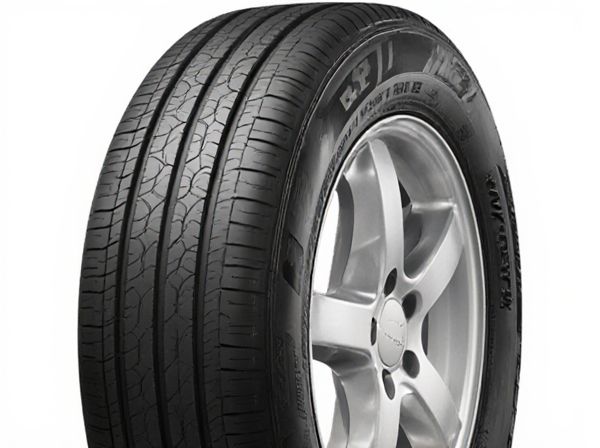
Photo illustration: Low Rolling Resistance Tire vs Standard Tire
Low rolling resistance tires improve fuel efficiency by reducing the energy lost as your tires roll on the road, helping you save money over time. Standard tires offer a balance of grip and durability but often consume more fuel due to higher rolling resistance. Choosing low rolling resistance tires enhances your vehicle's environmental impact without compromising everyday performance.
Table of Comparison
| Feature | Low Rolling Resistance Tire | Standard Tire |
|---|---|---|
| Fuel Efficiency | Improves fuel economy by reducing energy loss | Standard fuel efficiency |
| Rolling Resistance | Lower rolling resistance, less drag | Higher rolling resistance, more drag |
| Grip & Traction | Adequate but may be slightly reduced on wet surfaces | Better traction and grip across varied conditions |
| Durability | Typically longer-lasting due to optimized materials | Standard wear rate |
| Environmental Impact | Reduces CO2 emissions via better fuel efficiency | Higher emissions due to increased fuel consumption |
| Cost | Generally higher upfront price | More affordable initial cost |
| Noise Level | Quieter ride due to specialized tread design | Standard road noise levels |
Introduction to Low Rolling Resistance vs Standard Tires
Low rolling resistance tires are designed with specialized rubber compounds and tread patterns that minimize energy loss while rolling, improving fuel efficiency compared to standard tires. Standard tires prioritize durability, traction, and ride comfort, often resulting in higher rolling resistance and increased fuel consumption. Choosing low rolling resistance tires can reduce greenhouse gas emissions and lower operating costs by enhancing vehicle mileage without compromising safety.
Understanding Rolling Resistance in Tires
Rolling resistance in tires refers to the energy lost as a tire rolls over a surface, directly impacting fuel efficiency and vehicle performance. Low rolling resistance tires are engineered with specialized rubber compounds and tread patterns to minimize energy loss, resulting in reduced fuel consumption and lower CO2 emissions compared to standard tires. Understanding the balance between rolling resistance, traction, and durability is crucial for selecting tires that optimize both environmental benefits and driving safety.
Key Design Differences
Low rolling resistance tires feature specialized tread patterns and rubber compounds that minimize energy loss by reducing friction and heat buildup, enhancing fuel efficiency. Standard tires typically have deeper tread depths and more aggressive patterns optimized for traction and durability rather than energy conservation. The key design difference lies in the balance of material composition and tread design aimed at lowering rolling resistance without compromising safety and performance.
Impact on Fuel Efficiency
Low rolling resistance tires reduce energy loss as the tire rolls, improving fuel efficiency by decreasing the engine's workload. These tires can enhance miles per gallon (MPG) by up to 3-4% compared to standard tires, significantly lowering fuel consumption and greenhouse gas emissions. While offering improved fuel savings, low rolling resistance tires often maintain comparable traction and durability to standard tires, making them a practical choice for eco-conscious drivers.
Tread Patterns and Rubber Compounds
Low rolling resistance tires feature specialized tread patterns designed to minimize energy loss by reducing deformation and friction between the tire and road surface. These tires use advanced rubber compounds with lower hysteresis, enabling less heat buildup and improved fuel efficiency compared to standard tires. In contrast, standard tires often have more aggressive tread patterns and softer rubber compounds that prioritize traction and durability rather than optimizing for energy conservation.
Performance and Handling Comparison
Low rolling resistance tires enhance fuel efficiency by minimizing energy loss during rotation, resulting in improved mileage compared to standard tires. Standard tires typically offer superior grip and handling responsiveness, providing better cornering stability and braking performance in diverse road conditions. Performance benefits of low rolling resistance tires may come at a slight cost to grip and traction, making standard tires preferable for drivers prioritizing handling precision and sporty driving dynamics.
Durability and Longevity
Low rolling resistance tires are engineered with specialized rubber compounds and tread designs that reduce energy loss, enhancing fuel efficiency without significantly compromising durability. Standard tires often use more traditional rubber blends, which may offer increased resistance to wear and tear but result in higher rolling resistance and decreased fuel economy. Studies reveal that while low rolling resistance tires may have slightly shorter tread life, advances in technology have narrowed the durability gap, making them a viable option for extended longevity and sustainable performance.
Environmental Benefits
Low rolling resistance tires significantly reduce fuel consumption by decreasing the energy required to maintain vehicle motion, leading to lower greenhouse gas emissions compared to standard tires. The improved tire composition and tread design enhance energy efficiency, contributing to decreased carbon dioxide output and better overall environmental performance. Choosing low rolling resistance tires supports sustainable driving practices and helps meet regulatory targets for reducing transportation-related pollution.
Cost Analysis: Initial Investment vs Savings
Low rolling resistance tires typically have a higher initial cost compared to standard tires, reflecting advanced materials and design aimed at reducing energy loss. Over time, the savings from improved fuel efficiency can offset the upfront price difference, resulting in lower total cost of ownership. Fleet managers and individual drivers should evaluate mileage, fuel prices, and tire lifespan to determine long-term financial benefits.
Choosing the Right Tire for Your Needs
Low rolling resistance tires improve fuel efficiency by reducing energy loss as the tire rolls, making them ideal for drivers prioritizing cost savings and environmental impact. Standard tires offer a balanced performance with better traction and durability, suitable for varied driving conditions and higher speed demands. Consider your driving habits, vehicle type, and typical road conditions to select the tire that best aligns with your fuel economy goals and safety requirements.
 caratoz.com
caratoz.com